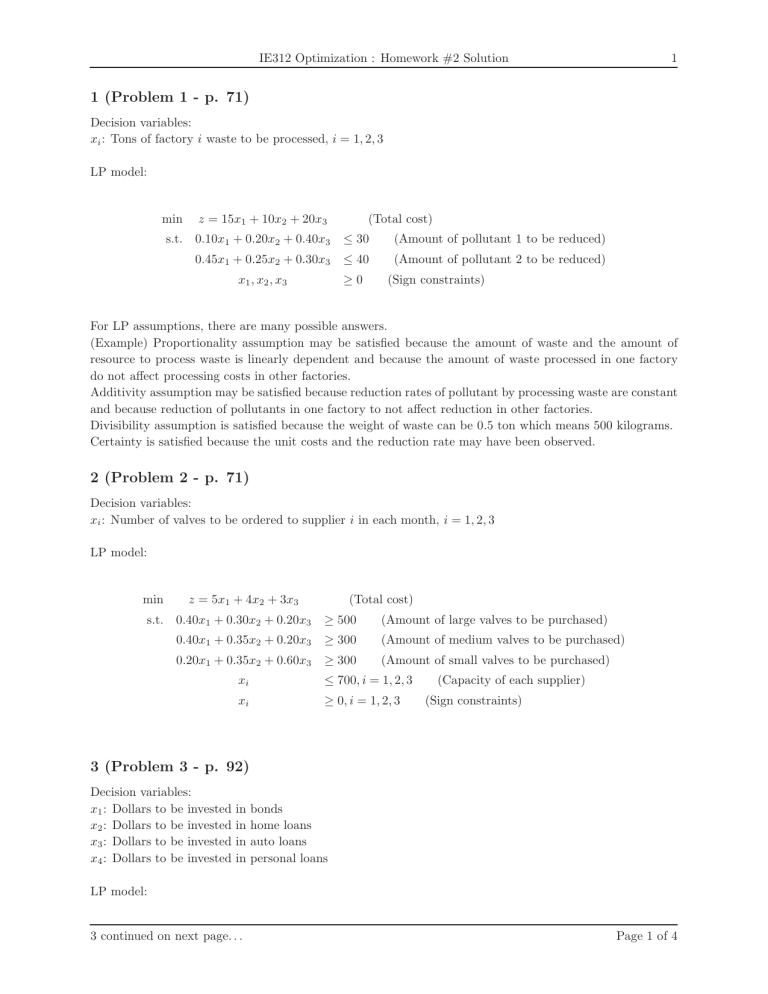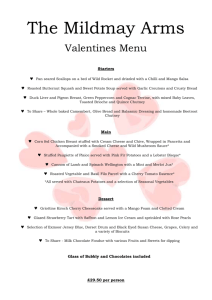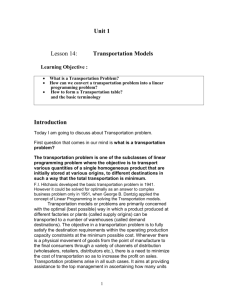1 (Problem 1 - p. 71)

IE312 Optimization : Homework #2 Solution
1 (Problem 1 - p. 71)
Decision variables: x i
: Tons of factory i waste to be processed, i = 1 , 2 , 3
LP model: min z = 15 x
1
+ 10 x
2
+ 20 x
3 s.t. 0 .
10 x
1
+ 0 .
20 x
2
+ 0 .
40 x
3
≤ 30
(Total cost)
(Amount of pollutant 1 to be reduced)
0 .
45 x
1
+ 0 .
25 x
2
+ 0 .
30 x
3
≤ 40 x
1
, x
2
, x
3
≥ 0
(Amount of pollutant 2 to be reduced)
(Sign constraints)
1
For LP assumptions, there are many possible answers.
(Example) Proportionality assumption may be satisfied because the amount of waste and the amount of resource to process waste is linearly dependent and because the amount of waste processed in one factory do not affect processing costs in other factories.
Additivity assumption may be satisfied because reduction rates of pollutant by processing waste are constant and because reduction of pollutants in one factory to not affect reduction in other factories.
Divisibility assumption is satisfied because the weight of waste can be 0.5 ton which means 500 kilograms.
Certainty is satisfied because the unit costs and the reduction rate may have been observed.
2 (Problem 2 - p. 71)
Decision variables: x i
: Number of valves to be ordered to supplier i in each month, i = 1 , 2 , 3
LP model: min z = 5 x
1
+ 4 x
2
+ 3 x
3 x i
(Total cost) s.t. 0 .
40 x
1
+ 0 .
30 x
2
+ 0 .
20 x
3
≥ 500
0 .
40 x
1
+ 0 .
35 x
2
+ 0 .
20 x
3
≥ 300
(Amount of large valves to be purchased)
(Amount of medium valves to be purchased)
0 .
20 x
1
+ 0 .
35 x
2
+ 0 .
60 x
3
≥ 300 x i
(Amount of small valves to be purchased)
≤ 700 , i = 1 , 2 , 3 (Capacity of each supplier)
≥ 0 , i = 1 , 2 , 3 (Sign constraints)
3 (Problem 3 - p. 92)
Decision variables: x
1
: Dollars to be invested in bonds x
2
: Dollars to be invested in home loans x
3
: Dollars to be invested in auto loans x
4
: Dollars to be invested in personal loans
LP model:
3 continued on next page. . .
Page 1 of 4
IE312 Optimization : Homework #2 Solution 3 (continued) max z = 0 .
10 x
1
+ 0 .
16 x
2
+ 0 .
13 x
3
+ 0 .
20 x
4 s.t.
x
1
− x
4
− x
2
+ x
3
0 .
25 x
1
+ 0 .
25 x
2
+ 0 .
25 x
3
− 0 .
75 x
4 x
1
+ x
2
+ x
3
+ x
4 x i
≥ 0
(Annual return on investments)
(restriction a)
≥ 0
≥ 0
(restriction b)
(restriction c)
≤ 500 , 000 (Available budget)
≥ 0 , i = 1 , 2 , 3 , 4 (Sign constraints)
4 (Problem 7 - p. 93)
Decision variables: x ij
: Oz of chemical i used to produce drug j
Revenue (in dollar): 6( x
11
+ x
21
) + 5( x
12
+ x
22
)
Cost (in dollar): 6( x
11
+ x
12
) + 4( x
21
+ x
22
)
Profit (in dollar): 2 x
21
− x
12
+ x
22
LP model: max z = 2 x
21
− x
12
+ x
22 s.t.
0 .
3 x
11
− 0 .
7 x
21
− 0 .
6 x
12
+ 0 .
4 x
22 x
11
+ x
21 x
12
+ x
22 x
11
+ x
12 x
21
+ x
22 x ij
≥ 0
(Total profit)
(at least 70% chemical 1 in drug 1)
≥ 0
≤ 40
≤ 30
(at least 60% chemical 2 in drug 2)
(Amount of drug 1 to be sold)
(Amount of drug 2 to be sold)
≤ 45
≤ 40
(Amount of chemical 1 to be purchased)
(Amount of chemical 2 to be purchased)
≥ 0 , i = 1 , 2 , j = 1 , 2 (Sign constraints)
5 (Problem 14 - p. 94)
Notations:
Index of input ( i ) – 1: reformate / 2: FCG / 3: ISO / 4: POL / 5: MTB / 6: BUT
Index of product ( j ) – 1: regular gasoline / 2: premium gasoline
Index of attribute of inputs ( k ) – 1: RON / 2: RVP / 3: ASTM70 / 4: ASTM130 c i
: Daily available liters of input i , i = 1 , ..., 5 a ik
: Attribute k of input i , i = 1 , ..., 6, k = 1 , ..., 4 d j
: Daily demanded liters of product j , j = 1 , 2 r jk
: Required attribute k of product j , j = 1 , 2, k = 1 , ..., 4 p j
: Sale price of product j per liter, j = 1 , 2
Decision Variables: x ij
: Oz of chemical i used to produce drug j
5 continued on next page. . .
Page 2 of 4
IE312 Optimization : Homework #2 Solution 5 (continued)
LP model: max s.t.
z = P
6 i =1
P
2 j =1
( p j
− 12 .
75) x ij
(Daily profit)
P
2 j =1 x ij
≤ c i
, i = 1 , ..., 5 (Availability of inputs)
P
6 i =1
( a ik
− r jk
) x
P
6 i =1
( a ik ij
≥ 0 , j
− r jk
) x ij
= 1 ,
= 0
2 , k
, j
= 1
= 1 ,
,
2
3 , 4
, k = 2
P
6 i =1 x ij
≥ d j
, j = 1 , 2
(RON and ASTM of gasoline)
(RVP of gasoline)
(Amount of gasoline to be produced)
0 .
38 x
1 j
− 0 .
62 x
2 j
+ 0 .
38 x
3 j
+ 0 .
38 x
4 j
+ 0 .
38 x
5 j
+ 0 .
38 x
6 j
≥ 0 , j = 1 , 2 (FCG limits) x ij
≥ 0 , i = 1 , ..., 6 , j = 1 , 2 (Sign constraints)
6 (Problem 2 - p. 97)
Decision Variables: x
1
: Number of unfinished tables to be manufactured x
2
: Number of unfinished chairs to be manufactured x
3
: Number of finished tables to be manufactured x
4
: Number of finished chairs to be manufactured
Revenue(in dollar): 70( x
1
− x
3
) + 60( x
2
− x
4
) + 140 x
3
+ 110 x
4
Cost(in dollar): 40 x
1
+ 30 x
2
Profit(in dollar): (70 − 40) x
1
+ (60 − 30) x
2
+ (140 − 70) x
3
+ (110 − 60) x
4
Hours of labor(in hour): 2 x
1
+ 2 x
2
+ 3 x
3
+ 2 x
4
LP model: max z = 30 x
1
+ 30 x
2
+ 70 x
3
+ 50 x
4 s.t.
40 x
1
+ 30
2 x
1
+ 2 x
2
+ 3 x
3
+ 2 x
4 x
1
− x
3 x
2
− x
4 x i x
2
(Profit)
≤ 40 , 000
≤ 6 , 000
≥ 0
≥ 0
(Amount of wood to be purchased)
(Total hours of skilled labor)
(Finished tables are made by processing unfinished tables)
(Finished chairs are made by processing unfinished chairs)
≥ 0 , i = 1 , 2 , 3 , 4 (Sign constraints)
7 (Problem 7 - p. 98)
Notations:
Index of milk ( i ) – 1: high-fat milk / 2: low-fat milk
Index of cheese ( j ) – 1: cream cheese / 2: cottage cheese
Decision variables: x ij
: Pounds of milk i to be directly used to produce cheese j (in lb/day) y i
: Pounds of milk i to be evaporated to produce cream (in lb/day)
7 continued on next page. . .
Page 3 of 4
IE312 Optimization : Homework #2 Solution z j
: Pounds of cream to produce cheese j (in lb/day)
Pounds of cheese j to be produced (in lb/day): z j
Fat of cheese j (%): (60 x
1 j
+ 30 x
2 j
) / ( x
1 j
+ x
2 j
)
+ P
2 i =1 x ij
Revenue(in dollar): 1 .
50( z
1
+ P
2 i =1
Purchasing Cost(in dollar): 0 .
80( y
1 x i 1
) + 0 .
90 × 1 .
20( z
2
+
+ P
2 j =1 x
1 j
) + 0 .
40( y
2
P
+
2 i =1
2
P x j =1 i 2 x
)
2 j
)
Production Cost(in dollar): 0 .
40 P
2 i =1 y i
+ 0 .
40 P
2 j =1 z j
+ P
2 i =1 x ij
LP model:
7 (continued) max z = 0 .
30 x
11
− 0 .
12 x
12
+ 0 .
70 x
21
+ 0 .
28 x
22
− 1 .
20 y
1
− 0 .
80 y
2
+ 1 .
10 z
1
+ 0 .
68 z
2 s.t.
(Profit) z
1
+ P
2 i =1 x i 1
≥ 1000 , (Amount of cream cheese to be produced)
1000 ≤ 0 .
90( z
2 z
1
+
+ P
2 i =1
P
2 i =1 x x i 1 i 2
≤
) ≥ 1000 ,
1500
(Amount of cottage cheese to be produced)
(Amount of cream cheese to be sold)
0 .
90( z
2
+ P
2 i =1 x i 2
) ≤ 2000 (Amount of cottage cheese to be sold)
P
2 i =1 y i
≤ 2000 (Capacity of evaporator)
P
2 j =1 z j
+ P
2 i =1 x ij
≤ 3000 (Capacity of cheese machine)
10 x
11
− 20 x
21
≥ 0
25 x
12
− 5 x
22
≥ 0
− 0 .
40 x
11
− 0 .
40 x
21
+ 0 .
60 z
1
≥ 0
− 0 .
20 x
12
− 0 .
20 x
22
+ 0 .
80 z
2
≥ 0
(Fat of cream cheese)
(Fat of cottage cheese)
(Proportion of cream in cream cheese)
(Proportion of cream in cottage cheese)
0 .
60 y
1
+ 0 .
30 y
2
− z
1
− z
2
= 0 (Yield of cream) x ij
, y i
, z j
≥ 0 , i = 1 , 2 , j = 1 , 2 (Sign constraints)
Page 4 of 4



